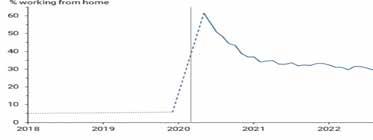
WINTER/SPRING 2023 UPDATE AND OUTLOOK
Every year starts off with experts making claims about where we are headed and headlines creating alarm about market trends. Both of these generally serve to confuse or mislead buyers and sellers leaving them wondering what their next move should be. In an effort to help create some clarity, it is our goal here to paint a picture of what we are seeing happening in the market, economy, and in the minds of our clients. We think that by taking a step back and looking at things from a 30,000-foot view, we are better able to remove the emotion that often leads to decisions that people regret. We hope the information on the following pages will help give you comfort in knowing that although there are certainly changing market conditions, this can be a great opportunity for buyers and sellers alike.
INFLATION AND ECONOMY
If you’ve filled your car up with gas, gone out to dinner, or really purchased anything recently, you have certainly felt the pinch of inflation and increased costs across the board. There are a number of reasons for this and we have touched on a few of them in past editions (see QR code in Buyer’s Corner). Inflation has been a factor for as long as any of us can remember, so why has it made so many headlines recently? The first part of this is that the rate of inflation that we have seen over the last year is higher than we have seen in nearly 40 years (see Chart 1). The second part, and the reason this is really hitting home for so many people, touches on affordability. In the past couple of years, we have seen a shift where although people’s wages have increased overall, the prices of goods have increased even more (see Chart 2). This creates an environment where people can’t keep up, and it is at least one of the reasons housing affordability has been such a hot topic.

However, there is good news on the horizon as wage growth has continued to climb while inflation has started to wane. Closing the gap between wage growth and inflation and establishing a better balance between these two data points is a key component in overall affordability. One of the reasons for this drop in inflation has been the Federal Reserve’s aggressive pattern of raising the short-term lending rate over the last twelve months. This has put a damper on the upward trend in prices by making it more expensive to borrow money and curbing the demand for goods and services. The big question is whether this is being done too quickly and whether that will lead the country into a recession. Although this certainly would affect people’s immediate financial situations, owning a home has historically been a positive thing during recessions and has led to price growth in five of the last six recessions.
HOMES FOR SALE
Every year we see the number of properties available for sale move in a fairly cyclical pattern. The amount of homes for sale (supply) typically rises from January until some point in the summer and then falls throughout the rest of the year. With the exception of 2020, this pattern has held relatively true to form and we would expect that this will remain true in the year to come. The big question this year will be how much of a surge in inventory will we see this spring. A few factors at play are the following:
• Some sellers have come to terms with the fact that they likely can’t get aspirational prices anymore, causing some pause on whether to sell.
• Most homeowners who refinanced in the last couple of years and currently have an interest rate that is near 3% don’t like the idea of selling and rebuying at 6-7%.
• As expected, builders have pulled back on their production and many have begun holding off on construction until there is an accepted offer on the property. This will also keep homes off the market.
• On the flip side, there are a number of sellers with properties available for sale as pocket listings in an effort to keep Days On Market low. If these properties become available on the MLS, this will cause the number of homes for sale to rise and offset the pressure of the first three on this list.
• According to a local report, there were 6,500 net new residents in Central Oregon in the first year of the pandemic. Since 2022 data isn’t in yet, if we assume this trend continued in the second year, that would put 13,000 new people in Central Oregon. If a small fraction of this number decides that Central Oregon isn’t right for them, or has their employer force a return to work, this could increase the number of homes hitting the market.
As we progress into spring and the forces above come into play, we do foresee an increase in the inventory of homes for sale. However, we still sit at a historic low of available homes, and a tripling of the inventory would still be seen as a balanced market (see Chart 3) making a dramatic swing in prices unlikely.
BUYER PATIENCE
Although there are plenty of factors that affect buyer demand, we think that without question, one of the largest factors that we have seen affect buyer motivation and ability is mortgage rates (see Chart 5). The rate increases and stock market declines in June and September had a noticeably negative impact on local buyer activity with Pending sales in both of those months dropping significantly as compared to years past (see Chart 4). We believe that this is still very reflective of buyer patience and not an overall lack of demand for the following reasons.
First, the drop in rates in late July/early August led to an unexpected bump in the number of Pending sales in August. That would indicate that many buyers didn’t disappear completely, they just sat on the sidelines for a bit. The second reason is that despite days on market increasing overall, there are still a large number of homes selling very quickly. In Q4 in Bend, roughly 26% of the homes went Pending in less than one week. For comparison, in 2019 in that same period of time, only 21% of the homes went Pending that quickly. The reason it feels so different right now is that in 2020 and 2021 these stats were closer to 40-50%. The buyers appear to be ready and willing to act when a home is presented well and priced accurately. However, when the home has deferred maintenance and is overpriced, buyers have shown that they are no longer willing to buy at all costs. In the Buyer’s Corner section, we will dive a little deeper into other factors influencing buyers and how they could affect demand.
FINAL THOUGHTS
Without a holistic understanding of the real estate market, change can be scary. Some are fearful as their only experience with housing market change was the 2008 financial and housing meltdown, yet we know that we are in a very different market. The Bend economy is more diverse, housing inventory is 15% of what it was in the late 2000s, and foreclosure rates are near an all-time low, all making it more stable than ever. As with all real estate investments, we feel that those done with a long-term horizon in mind and with an informed plan will stand the test of time. As always, we are here to empower you to make housing the foundation for a prosperous life here in Bend. We welcome you to reach out to help discuss your property needs, both now and in the future.
MORTGAGE
In the fall edition of this report, we discussed the percentage of the market made up of cash transactions, first-time homebuyers, and cancellation rates of purchases. For a more in-depth discussion on these topics, please scan the QR code to the left to access the data. Given that many of the trends discussed in that report have remained consistent, we will instead focus on some topics that should really be on buyers’ radars this year to see who they will be competing against and at what cost.

HOUSEHOLD FORMATIONS
We bring this up in relation to buyers but this can really apply to sellers as well, since this information helps us determine how many people or families may be coming into the market. We have witnessed new households increasing at a rate that hasn’t happened in almost 20 years.
were remote prior to the pandemic, but in mid-2020 about 60% of the workforce shifted to remote work. Since then, we have drifted to about 30% of the workforce still working remotely, and this has stayed relatively consistent over the last year (see Chart A). It would appear that the fear of being called back to work is not as widespread as previously thought, and for the time being, this will continue to be a viable option for buyers.
INTEREST RATE EXPECTATIONS

People often think that Federal Reserve interest rate changes are what drive mortgage rates, but this is not entirely accurate. Mortgage rates are actually very closely correlated with movements in the yield for the 10year treasury note and there is normally a consistent spread between the two (see Chart B). What we saw at the end of 2022 was that the spread between treasury yields and mortgage rates was higher than it has been in some time. This is very likely because banks are adding a premium to rates knowing that buyers will likely refinance if rates should fall again in the coming year(s). We don’t know if this will be the new norm or if this will come back inline, but without a doubt, the number one thing you can do is talk to your lender in advance and discuss what kind of payment you can afford and what your loan options look like. With things like interest rate buydowns and adjustable rate mortgages, there are options for buying now and protecting yourself against future rate increases. At the same time, if rates drop in the future, you can use a refinance to take advantage of this and lock in a lower rate. If you can afford the payment now, you don’t have to sit on the sidelines, you just need to be aware of your options.
One of the largest factors is that millennials are stepping into the market for the first time. They are going from living with friends or family to purchasing their own homes and currently make up 43% of the buyer market. With the largest share of the roughly 73 million millennials at their peak homebuying years (30-34 years old), economists see this trend holding strong for the next five to seven years. Another reason affecting household formation is the ability to work remotely. As people living in higher rent areas with two to three roommates were given the option of working remotely and living somewhere else on their own, this promoted new household formation. Nationally, it is estimated that 5% of workers








